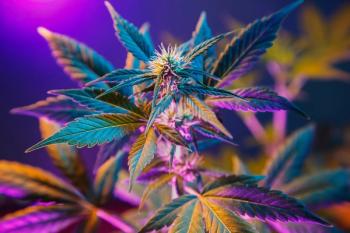
- August 2021
- Volume 2
- Issue 2
Two Stories Of Lives Lived By Keeping Epilepsy At Bay: Cannabis Was The Key Discovery That Freed These Patients From The Pain And Suffering Of An Ancient Incurable Disease
Two medical cannabis patients—Vanessa Jones and Deborah McCauley—share their stories about choosing cannabis for epilepsy treatment.
Two medical cannabis patients share their stories about choosing cannabis for treatment: Vanessa Jones, suffering from epilepsy all her life that has finally begun to subside; and Deborah McCauley, a registered nurse with a background in mainstream medicine who is also facing her own challenges with epilepsy. Jones talks about the initial treatments doctors recommended that didn’t work, and why cannabis allowed her “to have some control of my epilepsy, regain my autonomy, and provide me a significantly greater quality of life.” McCauley’s path to cannabis began as a medical mainstream insider who gained more insight as she changed the treatment for her seizures from the usual pharmaceutical regimen to cannabis—while facing backlash from the medical community. “I have to say it still amazes me that the existence of an entire body system, our endocannabinoid system, is negated by the stigma of a plant,” McCauley said. “It’s still so fascinating for me to see people argue against the science that is very clearly available.”
Epilepsy has challenged mainstream medicine since it was first observed thousands of years ago. One of the oldest Babylonian medical texts, Sakikku (English translation: “All Diseases”), dating from around 1050 BC, includes the reportedly oldest written account of epilepsy (1).
Since then, researchers have discovered that it may be inherited. For example, if a person has a first-degree relative (mother, father, sibling) with epilepsy, the risk of developing epilepsy by the age of 40 is less than 1 in 20 (2).
But the likelihood of inheriting epilepsy may differ significantly if a person has a relative with a known genetic epilepsy diagnosis. In this case, the chance of developing epilepsy depends on the specific gene and inheritance pattern involved. Certain types of epilepsy are associated with specific genetic changes, including changes in an individual gene or changes in a chromosome.
Researchers have discovered that people with a clinical diagnosis of Dravet Syndrome, one of the more rare forms of epilepsy that is drug resistant (3), are likely to have a variant in a gene called SCN1A (4). Usually, the variant in SCN1A is a de novo variant, meaning that the variant arose in either the egg or the sperm cell and the parents do not have the
SCN1A variant.
The first few epilepsy-related genes were identified in the late 1990s. Advances in DNA sequencing now have identified hundreds of genes that play a role in epilepsy; new genes are being identified on a regular basis, some of which are specific to epilepsy.
Still Clouded in Mystery
But medical science is still stumped about the real origins of epilepsy, and still experimenting with treatments that are generally based in pharmaceuticals.
Researchers are just beginning to learn about specific genes and the types of epilepsy associated with them. In many instances, it may be hard to predict an individual’s epilepsy prognosis because more research is needed, according to the Epilepsy Foundation (5).
Today, using cannabis to treat epilepsy has moved to the top of the list of options. There is a growing batch of data and anecdotal accounts that shows it works. In fact, treating epilepsy with cannabis is quickly becoming the go-to choice for some doctors who have taken the time to learn more about cannabis. But there are still questions about its efficacy—and the scourge of epilepsy marches on.
The Macro—and Micro—View
The statistics tell a chilling story. There are 65 million people around the world who have epilepsy; 3.4 million people in the United States have epilepsy; 470,000 children in the United States have epilepsy; one in 26 people in the United States will develop epilepsy at some point in their lifetime; and there are 150,000 new cases of epilepsy in the US each year (6).
One of the people who likely inherited a genetic disposition to epilepsy is Vanessa Jones, the founder and CEO of Your Virtual Right Hand (7), an executive assistance, marketing, and business development firm.
Jones was diagnosed with epilepsy at 8 years old. “It wasn’t a big surprise,” she said. “I have epilepsy in my family and there’s at least one epileptic every generation. Because we had experience with epilepsy, my mother opted to not put me on medication.”
Jones had one or two seizures a year until she was 13. “Then, it just stopped,” she said. “It wasn’t until I was in a serious car accident after my high school graduation that my seizures came back.”
She was having three seizures within a single episode, and had to take Lamictal (8), an anti-convulsant, for seizure control so she could attend college. “Lamictal was a nightmare for me as it kept me in a constant state of anxiety,” Jones said. “I wasn’t able to attend my classes and had to move back home to be on ‘watch.’”
In 2005, Jones began taking medical cannabis to gain some control of her epilepsy and regain her autonomy, giving her a significantly greater quality of life. “Unfortunately my doctors at the time, between 2010–2014, were not receptive of cannabis as an alternative treatment plan and wanted to continue changing my medication cocktail,” she said.
She initially started taking 1 gram of full extract cannabis oil (FECO) a day because research showed cancer patients were experiencing remission using that same dosage. “So I figured if it worked for cancer, why not seizures?”
It took her about two months to get to 1 gram of FECO a day. She takes a half gram at 4:20 a.m. and a half a gram at 4:20 p.m. “I was lucky when I started in 2010 that California growers under Proposition 215 (9), the Medical Marijuana Initiative, and California Senate Bill 420 (10) provided compassionate care programs that supplied me with organic and clean medicine for cheap, as well as guidance on dosing and further education about the plant,” Jones said. “At that time, I had access to 2:1 CBD/THC ratio through California growers, and kept a journal on how dosing made me feel, and recorded seizures or auras.” (An aura is the term that some people use to describe the warning they feel before they have a seizure [11].)
During her transition to cannabis, she had two seizures within the first four months, she said, and has been seizure-free for years now.
Epilepsy is a qualifying condition in California, she said, along with many other states (12). “But now with California Proposition 64 (13), and the lack of accessibility and affordability of medical cannabis, I have to cut my dosage to conserve the supply I can find from California growers who still cater to the medical cannabis market. If I have the extra funds and run out of medicine, I am limited in availability and options of strains and CBD/THC ratio, and have to travel more than hour to the nearest dispensary. A 1: 1 RSO (Rick Simpson oil) from a dispensary can cost between $80-$160 a gram and that’s not including tax.”
Overcoming Obstacles: Tough Choice for a Trained Medical Professional
Another medical cannabis patient, Deborah McCauley, BSN, CRRN (CRRN is a type of rehabilitation nurse certification) comes from a unique background within the medical community, having served as a combat medic for the U.S. Air Force.
But her interest in medicine began much earlier. “I started my medical career when I got my first CPR card at the age of 10 from the Babysitters Club of America,” McCauley said. “That’s where my stage was set. I volunteered in an emergency room when I was 16 and subsequently joined the United States Air Force when I was 19.”
McCauley was a combat medic for two years, diagnosed with temporal lobe epilepsy before being honorably separated from the Air Force. She returned home to northern Virginia, where she continued to work as a medical assistant until she met her husband. “He encouraged me to go back to school to obtain my RN,” she said.
But it wasn’t until 2014 when a friend told her that cannabis could be beneficial for the pain she had been dealing with as a rehabilitation nurse working with heavy patients. “Of course, my ‘just say no’ training gave me pause,” McCauley said. “But it wasn’t very long before I gave it a go.”
McCauley was using various pharmaceuticals at the time to maintain control over her epilepsy. “I used to take a lot of pharmaceuticals. I mean, over the years I have probably tried every seizure medication possible and I kept going back to one very old medication,” she said. “But I had no idea how it was affecting me. I was personally unaware of the side effects until my husband asked me why I was acting so dumb, I was experiencing severe cognitive difficulty, which was affecting our communication. I had no idea that there were other options out there.” She slowly transitioned over to only cannabis for both her pain and her epilepsy, with her
neurologist’s approval.
She said that using cannabis helped bring mental clarity to her studies as she worked on getting her Bachelor of Science in nursing degree. “It got my nursing brain working,” she said. “How did cannabis work so well? Why did it work so well? Why were we all lied to?”
She eventually connected with the local Virginia NORML chapter, then reached out to both the American Cannabis Nursing Association (ACNA [14]) and the Cannabis Nurses Network (15).
“I lobbied at the Virginia State Capitol in January of 2019. Our ask was to ‘Let Doctor's Decide,’” she said. “I have been integrating myself into the field and really putting myself out there as an activist and an advocate for the needs and the rights of patients.”
McCauley is currently in pursuit of a Juris Master's from Florida State University School of Law with a focus in healthcare regulation. It is here she hopes to gain more insight on how to positively change the perception surrounding entheogenic plant medicines.
Fighting Negative Perceptions
At first, it wasn’t easy to make the choice of treating herself with cannabis. “I struggled with discontinuing my medication because of that stigma that was ingrained within me,” McCauley said. “But after learning more and seeing that the conversation was being had, that’s when I joined several associations and started to understand more. It was truly eye opening. I’ve been on a mission ever since to dispel the lie that was told to us so long ago. Cannabis is now the only medication I use to maintain control over my epilepsy and my other ailments, like my chronic pain, my ADHD, and all of the fun perimenopausal symptoms that I’m experiencing as I age gracefully.”
McCauley retired from bedside nursing in 2018 due to injury and burnout. “Most of the comments I get is that I’m just a stoner that just wants to get high who is hiding under the guise of medical use,” she said. “Sadly, this is prohibitionist thinking. It is encouraging that more and more healthcare professionals are pulling back the curtain and recognizing the science. But some want to hold on to the past.”
Although cannabis is not a panacea, she said, it can be a therapeutic tool for those who choose this modality. “Part of what we need to do is to fix our broken healthcare system by returning some of that autonomy to our patients so they can be in charge of their own health.”
McCauley moved to Florida in the fall of 2019 where she takes a whole plant oil that is predominantly CBD with a little bit of THC—on average of a 10:1 CBD to THC ratio oil, taking half of a dropper every night. “I have yet to discover any difficulties in my regimen,” she said. “I’ve been pretty consistent, just like I would take a medication, just to make sure that I’m maintaining control over my epilepsy. And I am feeling pretty good.”
Taking the Next Steps
One project she’s been working on in Florida is to advance legislation within the state in order to make it mandatory that education about the endocannabinoid system is presented to all nurses during their yearly continuing education courses.
“For the most part, there is little to no medical education that is received for initial medical use here in Florida,” she said. “It’s pretty scary. We’ve got a lot a lot of elderly here, and they don’t necessarily understand this concept of treatment. The model here in Florida requires the patient to see a recommending doctor, which we have to pay out of pocket for. Then we go to the dispensary and there is no medical representation available whatsoever. It’s frustrating that there isn’t very much education being given to the patients who come in to the program.”
For now, McCauley is ramping up an organization she created—called “NurseDebb” (16)—working closely with the Cannabis Nurses Network, who empower nurses through education, opportunity, recognition, and advocacy. She is also the lead on the Advocacy Cornerstone Project, working as a freelance public speaker and an adviser on legislation and advocacy projects. “I have a couple of projects I am working on currently. Everything’s in various stages. I am really trying to help advance that language within the legislation and doing some policy development.”
“Cannabis is not what we’re used to,” McCauley said. “We have to step outside of the box that society has created and the paradigms of yesterday to learn that there are different ways to improve our health and regain our homeostasis.”
Conclusion
Jones said she believes people are still greatly unaware of the medical benefits of cannabis and hemp for epilepsy and seizures because of the lack of education, research into alternative treatments, and awareness of the different types of ways to consume the plant for medicine. “We can’t ignore the strong stigma that has always been attached to cannabis in general,” Jones said. “The cannabis industry has come this far because of the medical cannabis community whose lives have been changed due to its medicine and have fought to have access to it. Reach out for help. Start reading the research behind medical cannabis. Talk to your neurologist and doctors about cannabis as an alternative treatment.”
McCauley agrees that the medical community needs to get on board with cannabis as treatment, and said that the stories from patients is “really where this plant medicine push is coming from.”
“Everybody is getting sick and tired of being told what to do and how to manage their lives,” McCauley said. “I have to say it still amazes me that the existence of our Endocannabinoid System is negated by the stigma of a plant. It’s just still so fascinating for me to see people argue against the science that is very clearly available.
“We have talked about this change for far too long. Legislation has been happening for far too long. I understand that change takes time, but our patients are running out of time. The Entheogenic Plant Medicine train is here, either get on it, or step aside. Be sure you are advocating for the change you want as individuals, as Americans, as humans,” she said. “My big message is to advocate for the most important patient of all—yourself.”
References
https://www.ncbi.nlm.nih.gov/pmc/articles/PMC7049807/ .https://www.epilepsy.com/learn/epilepsy-due-specific-causes/genetic-causesepilepsy/epilepsy-and-genes. https://www.epilepsy.com/learn/types-epilepsy-syndromes/dravet-syndrome .https://www.ncbi.nlm.nih.gov/pmc/articles/PMC2937162/ .https://www.epilepsy.com/about-us/about-foundation .https://www.epilepsy.com/living-epilepsy .https://www.linkedin.com/in/vanessa-jones-290a0b129/ .https://www.drugs.com/lamictal.html .https://ballotpedia.org/California_Proposition_215,_Medical_Marijuana_Initiative_(1996) .https://leginfo.legislature.ca.gov/faces/billTextClient.xhtml?bill_id=200320040SB420 .https://epilepsysociety.org.uk/epilepsy-auras .https://www.ncbi.nlm.nih.gov/pmc/articles/PMC6398594/ .https://www.courts.ca.gov/prop64.htm .https://www.cannabisnurses.org .https://www.cannabisnursesnetwork.com .https://www.linkedin.com/in/veteranrndeb/ .
Articles in this issue
over 4 years ago
August 2021 Digital Editionover 4 years ago
Medical Cannabis and Caregiver Rights in Hawaiiover 4 years ago
Charlotte Figi: Patient, Advocate, Trailblazer, and Much Moreover 4 years ago
Cannabis Becomes One Nurse’s Tool to Treat Epilepsy DisordersNewsletter
Unlock the latest breakthroughs in cannabis science—subscribe now to get expert insights, research, and industry updates delivered to your inbox.




